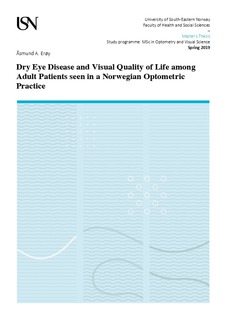| dc.description.abstract | Purpose
To explore the visual quality of life (VQoL) of patients attending Norwegian optometric practice for a dry eye examination.
Methods
In total 49 patients underwent a thorough dry eye examination at the Norwegian
Optometric Clinic Eroy Optikk in the period June - July 2018. The examination included two questionnaires, the Ocular Surface Disease Index (OSDI) and the National Eye Institute 25-item Visual Function Questionnaire (NEI VFQ-25) and a range of dry eye tests according to Tear Film & Ocular Surface Society (TFOS) International Dry Eye Workshop 2 (DEWS II) workup scheme. Group differences and associations were analysed using standard parametric and non-parametric statistical tests, a p-value < 0.05 was considered significant.
Results
The patients mean (sd) age was 48 ( } 13) years, 29 (59 %) were female. In all, 33 (67 %) had dry eye symptoms (OSDI ≥ 13). Among these, 97 % (n = 32) were diagnosed with DED, of these 41 % had evaporative dry eye (EDE), 34 % had mixed dry eye, 12.5 % had aqueous-deficient dry eye (ADDE), and 12.5 % was unclassifiable. There was no significant difference in the frequency of DED between females and males, and the mean age was not different between patients with and without DED. Reduced score for quality of NEI VFQ-25 general vision (general vision) was moderately correlated with increased dry eye symptoms (OSDI score, r = - 0.5, p < 0.001); there was no significant difference in the severity of DED symptoms (OSDI) between females and males.
Females reported significantly lower on quality of general vision than males, 74 ( } 15) versus 84 ( } 15) (Wilcoxon’s rank sum test, p = 0.02). There was strong correlation between NEI VFQ-25 ocular pain score (ocular pain) and dry eye symptoms (OSDI score) (r = - 0.7, p < 0.001). Moreover, findings of DED were moderately correlated with more ocular pain (r = - 0.51, p < 0.001). There was no significant difference in ocular pain score between females (68 } 19) and males (76 } 22). Twenty-four patients needed some sort of DED treatment; all of them were advised to use artificial tears and/or eye lubricants, among them, seven patients were started on basic MGD treatment (heat, massage, eyelid-hygiene). Two participants needed referral to ophthalmologist after basic DED treatment.
Conclusion
In this study, patients’ VQoL was reduced by DED. Patients with DED experienced more ocular pain and poorer general vision than non-DED patients. These findings suggest that DED and its adverse, negative, effects on VQoL is a public health issue in Norway.
We propose that preventing or treating DED is beneficial because it can reduce ocular pain and poor vision, which can be a burden for both the patient and the society, and that DED, should be a subject of sheared-care between optometrists and ophthalmologists. Further studies should explore the prevalence of dry eye in the general population in Norway and the effect of systematic dry eye assessment and treatment in Norwegian optometric practice according to the new diagnostic guidelines given in DEWS II. | nb_NO |
